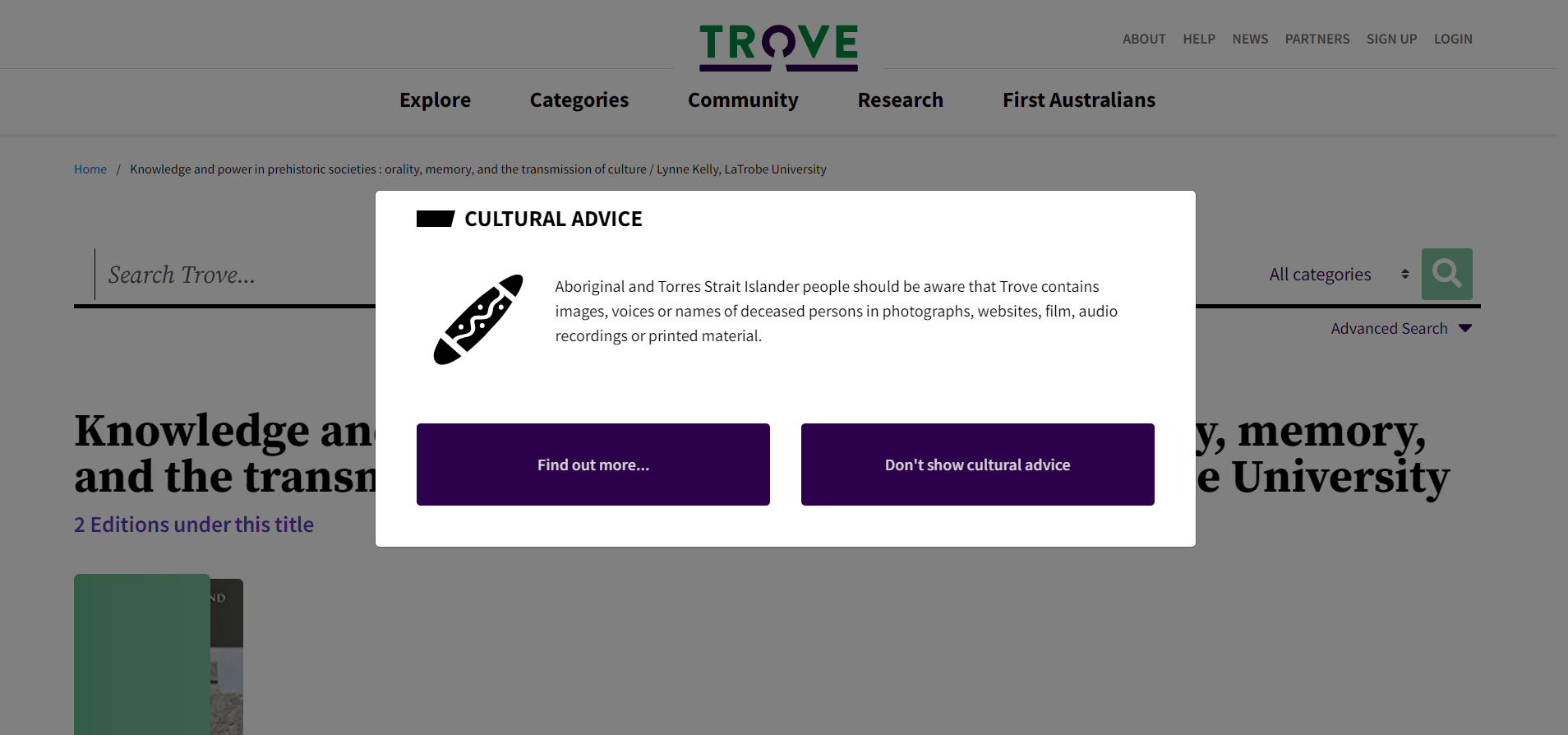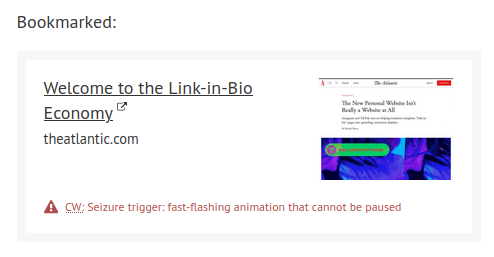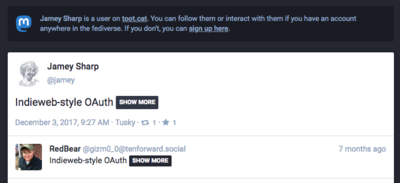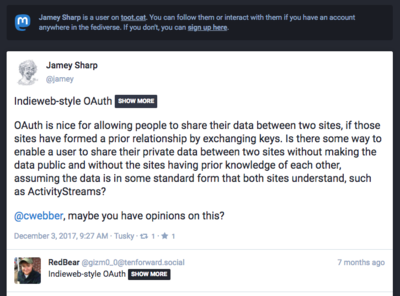content warning
This article is a stub. You can help the IndieWeb wiki by expanding it.
content warning is a feature of a post create UI where an author can hide some or all of the primary content of a post due to concerns about negative impacts of the content upon viewers, and typically provide a text warning (eponymously named) with the nature of the concerns, which is initially displayed instead of the post content.
IndieWeb Examples
(this section is a stub)
fluffy
 fluffy publishes some posts with content warnings, which means they are treated differently when displayed on index pages (including RSS/atom feeds), vs. in the full entry context.
fluffy publishes some posts with content warnings, which means they are treated differently when displayed on index pages (including RSS/atom feeds), vs. in the full entry context.
Some examples:
- Atom feed: Normally entries get full-content; however, if there's a CW/cut for whatever reason, that is hidden behind a "read more"
- Comics: CWs will collapse the entry preamble into a
<details>, e.g. http://beesbuzz.biz/comics/guest/?id=161 or http://beesbuzz.biz/comics/guest/161-Pushy-Garnet-Vitreous-Lava-Tickling#isso-thread- Publ also has the capability of providing different crops on an index vs. full page, although the beesbuzz.biz site templates currently (as of 9/23/2019) do not make use of that.
- Blog entries: CW for the "read more" link as well as on the full entry page, e.g. https://beesbuzz.biz/blog/1371-There-are-no-happy-endings; also used for spoilers, e.g. https://beesbuzz.biz/blog/4193-She-Ra-Season-5-opening-titles
- Templates also override Publ's auto-summary function for page unfurls and mf2 cards
sebastiangreger.net
![]() Sebastian Greger displays a warning when presenting bookmarked websites that have accessibility flaws with potential for seizures (permalink):
Sebastian Greger displays a warning when presenting bookmarked websites that have accessibility flaws with potential for seizures (permalink):
Other Examples
Trove
Trove is an Australian-based website that has pop up content warnings that provide cultural advice for indigenous peoples who may have issues with images and audio of deceased persons.

Software Support
Mastodon
In Mastodon a "Show More" button allows a viewer to explicitly decide they want to reveal and see the content that has been hidden by default by the author.
In ActivityPub, this post is represented with a summary property of "Indieweb-style OAuth" and the content property is the full text of the post.
Brainstorming
proposed p-content-warning
There is a proposed p-content-warning property addition to h-entry for a text warning that would be initially displayed instead of the summary or content properties.
Preventing Spoilers
One potential use case for a Content Warning would be to prevent spoilers. If I want to post about a new episode of Game of Thrones, it would be useful to put a CW on it with a reference to a reason (Game of Thrones Spoilers). This would allow a reader to minimize the post with a reason it is minimized "Game of Thrones Spoilers". This allows someone to tap on it and reveal the hidden message inside.
- Potential cons:
- Usability: Having to click to view a ton of posts in your timeline
- Not using it: 99 Posts might be properly covered by CW but then 1 person might not, still spoiling it.
- Alternatives:
- IRC conversations on this:
Ideas
- Is there a way to categorize CW posts so that if you unhide one of a specific category in a reader you could unhide the rest of the same category?
- Post content of a CW would be the normal post. It would just need some way to indicate that it was a post with sensitive content and potentially a way to either provide a reason or a category. This could be as simple as adding something like a
p-warning-reasonor something to that extent.
UX issues
When providing a CW, it's important to remember that there are different navigation paths one might take to a page. It might be tempting to have the CW itself on one's feed and then unfurl the content on the entry page, but keep in mind that someone might navigate to an entry via a different path, such as a previous/next link from another entry, or an external search result from a search engine.
For many small updates in succession, there should always be an option to "unfurl all."
CWs should also not be used habitually to hide absolutely everything; on Mastodon there is a tendency for people to over-CW things and as a result many users have reported getting into the habit of unfurling everything without thinking about it, and then being shocked/upset by seeing a thing they weren't expecting.
See Also
- spoiler post
- https://twitter.com/Discardia/status/1028466127116988416
- "One last thing: there is a social norm on Mastodon I find rather lovely. When composing a message you can enable content warnings to allow you to hide spoilers or information which can be disturbing for some people." @Discardia August 12, 2018
- Potential mis-use of content warning as suggested on Mastodon by one user: https://bobadon.rocks/@bobstechsite/100560577910267903
- "Friendly reminder: this isn't Twitter.If you're mad about something? Use a content warning.If you want to write a long post? Use a content warning.Don't share screenshots of toots that make you mad, and don't follow people that make you mad.You've left the swirling fire vortex of rage birdsite created to keep investors and advertisers happy. Live free! Live well 👍" @bobstechsite August 16, 2018
- Feedback on Micro.blog including reasons for having CW http://articles.inqk.net/2018/08/20/micro-blog-improvements.html
- suggestion of using subjects to define what the content warning is about https://pleroma.site/objects/c456e037-425f-4eba-aeee-fb64367ba4dc
- "people should just treat what Mastodon calls content warnings like subjects. just say what the post is about. easy." @kaniini August 19, 2018
- discussion for explicit CW vs summary in AP – deferred to "later"
- Study criticizing “trigger warnings”: https://journals.sagepub.com/doi/10.1177/2167702620921341
We found no evidence that trigger warnings were helpful for trauma survivors, for participants who self-reported a post traumatic stress disorder (PTSD) diagnosis, or for participants who qualified for probable PTSD, even when survivors’ trauma matched the passages’ content. We found substantial evidence that trigger warnings counter therapeutically, reinforce survivors’ view of their trauma as central to their identity.
 fluffy’s response to the above: On content warnings
fluffy’s response to the above: On content warnings
- Example:
Offensive Content Alert: Warning. The National Jukebox contains historic recordings that reflect the culture of an earlier era. Some of these recordings may be offensive. For more information, please read our Disclaimer.
—Library of Congress National Jukebox
- A walkthrough of how someone build a content warning component with
<details>on their blog: https://kittygiraudel.com/2022/09/04/a-content-warning-component/



